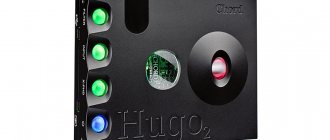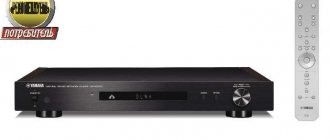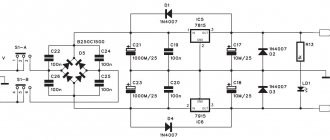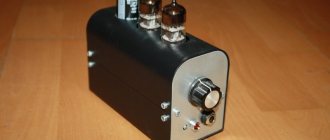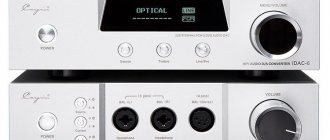Chord Hugo portable amplifier/DAC review
A portable DAC/amplifier with a price tag well over a hundred thousand rubles - this offer may seem a little impudent. But not in the case when it is decorated with the thoroughbred logo of Chord Electronics, which, in fact, does not deal with any portable little things, but with top-end High-End devices and professional studio equipment for respectable gentlemen from the BBC, Sony Music and Abbey Road Studios. A small device with a big name and extraordinary capabilities first appeared at the last CES and made a lot of noise there - this was not surprising, because the creators presented it as not only the most compact, but also the most sophisticated, as well as the coolest-sounding DAC in their extensive catalog. Now he has finally reached us. It's time to get acquainted!
Body type
Portable? Yes. Pocket? I think no. Compared to the multi-kilogram HIgh End giants from the Chord catalog, the new device seems miniature, but in fact it is not so small. It weighs 400 grams, slightly resembles a vintage discman and obviously does not fit into every pocket. In any case, you will have to give up the idea of carrying it in your jeans pocket once and for all (or, in extreme cases, buy jeans three sizes larger than usual).
The durable shell made of aluminum, subjected to special treatment using aerospace technologies, is designed to emphasize the premium quality of the product, however, by the usual High End standards it looks a little frivolous. Instead of a solid rotary control, which is the status of the device, the output signal level is regulated by a funny transparent wheel, reminiscent of a ball of antiperspirant gel and equipped with a colored backlight. Nearby is another frivolous decoration - a decorative round window through which you can admire the expensive filling. However, the window has not only a decorative, but also a completely functional role: by its illumination you can find out about the sampling frequency of the received audio stream.
At the minimum frequency, 44.1 kHz, the backlight is red, at the maximum, 384 kHz, it is purple. By the way, no, we did not mistype. This portable device is truly capable of processing high-resolution images with incredible 384 kHz clarity, inaccessible to many stationary giants! How does he do this?
Internal organs
To understand where the compact Chord Hugo gets its unusual superpowers, it’s worth getting to know its internal structure. And it is very extraordinary! Starting with the very basics - the digital-to-analog converter. Instead of one of the usual chips from Wolfson, Burr-Brown or Cyrrus Logic, the input audio stream is converted by a complex semiconductor structure based on an FPGA - a programmable gate array manufactured by Xilinx.
The use of a gate array with its flexible configuration capabilities allowed Chord developers to abandon many of the technical limitations inherent in traditional DACs - for example, to increase the number of digital filters involved in the circuit by almost two hundred times - from 150 to 26 thousand! As a result, the complexity and accuracy of digital filtering algorithms used in digital-to-analog conversion has increased by an order of magnitude, and the device's ability to process raw audio raw materials has jumped to 384 kHz. Another important advantage of the FPGA matrix is its low power consumption. Conventional audiophile DACs consume a lot of energy, requiring developers of portable devices to increase the battery capacity or put up with low battery life.
With Chord Hugo, everything is different - the battery does not take up extra space, charges in a couple of hours and works for almost 14 hours. To achieve similar autonomy and comparable sound quality without a gate array, developers would have to equip their device with a battery weighing half a centner! The gate array at the heart of the Chord Hugo design is responsible not only for converting the digital audio stream into analog form, but also for a host of other important responsibilities, from decoding the input signal to controlling the audio level at the output. By the way, what does the gadget have with inputs and outputs? Let's see.
Chord Electronics Hugo 2 / DAC and headphone amplifier
Chord Hugo 2 is the world's most advanced battery-powered DAC. The entire digital-to-analog conversion process is implemented on powerful FPGAs, with unique decoding, interpolation and digital filtering algorithms developed by Chord Electronics Chief Digital Engineer Rob Watts.
Description
The Chord Hugo2 is a high-resolution (up to 32-bit/768 kHz and DSD512) digital-to-analog converter that implements digital filters and DACs in software using FPGAs.
Interpolation and filtering algorithms were developed by Chord Electronics lead engineer Rob Watts and are aimed at perfectly reconstructing the recorded music signal in the time domain, since our ears are extremely sensitive to distortions in the time of arrival of sounds. Modern, powerful FPGA chips allowed Hugo 2 to harness the power of simultaneous operation of 45 processor cores operating at a clock frequency of 208 MHz for the needs of analog signal reconstruction and process the signal with an accuracy of 49,152 weighting coefficients (digital filter lengths).
Due to the algorithmic implementation of D/A conversion, absolutely unique technical characteristics are obtained: Hugo 2 has no jitter (phase instability of the clock signal), there is no signal modulation of noise and interference, the noise shaper has its own noise level below 260 dB. All this gives the highest signal resolution in the time domain, which is absolutely unattainable for other DACs, and is perceived by ear as “non-digital” purity and transparency of sound.
Chord Hugo 2 is not only the most advanced DAC, but also a unique headphone amplifier based on discrete elements, which operates with a huge margin in class A even at loads above 300 Ohms, which ensures the “drive” of any headphones.
The cast aluminum housing serves as a radio interference shield and cooling element. The best lithium-ion batteries produced by Enix Energies (2 x 2600 mAh) are used for power supply. In Desktop mode, when the charger is connected, the batteries do not wear out.
Finishing
Black or silver anodizing
Completeness
- USB memory (5 V, 2 A), interchangeable plugs for different countries
- USB – Micro USB cable (1.2 m) for charger
- Micro USB – Micro USB cable (OTG, 15 cm) for connecting to an Android smartphone
- IR remote control
- Instructions
Case
On sale are genuine leather cases “Case for Hugo 2” (standard) and “From the Japanese studio VanNuys” (designer).
Wireless music module
The Chord Electronics 2Go network set-top box adds Hugo 2 network card functions (Wi-Fi, Bluetooth A2DP, Ethernet Gigabit LAN), a card reader for two MicroSD drives, a server and a UPnP renderer for iOS, Android, Linux, Windows, MacOS, etc.; AirPlay audio output devices for Apple; Endpoint for Roon; audio output devices for Internet services TIDAL, QOBUZ, etc.
Additional information on our website:
Choosing the best cables for Chord Hugo 2
Switching 4 types of digital filters on Chord Hugo 2
Driver for Windows (supports 768 kHz sampling rate)
Color map of all indicators
Sample rate indicator color map
Inputs-outputs
With the outputs, everything is simple - there is a stereo pair for connecting an external amplifier and three headphone outputs - one standard jack and a pair of mini-jacks. The device supports any impedance starting from 4 ohms, so it will not be confused by either low-impedance in-ear monitors or super-voracious headphones for studio purposes. For those who like everything to play in their headphones “as if from natural speakers,” the Crossfeed function is available, triggered by a switch on the right side. The function mixes left and right stereo signals together to create a live sound effect, and operates in three fixed modes from a minimum level of 9 dB to a maximum level of 4.5 dB.
As for the inputs, here Chord Hugo presents several pleasant surprises, starting with a variety of input interfaces that is unusual for portable equipment. There are five of them here. The first is wireless Bluetooth with support for the advanced aptX codec, which allows you to stream music without additional compression. Two digital - optical and coaxial. The optical input is ready to accept high-cuts with a resolution of up to 192 kHz, and the coaxial input raises the bar to a maximum of 384 kHz. A real treat for a stereophile with a keen ear and plenty of space on network storage! Along with two digital interfaces, Hugo is equipped with two microUSB ports. The first is designed to receive audio streams of standard 44.1 kHz and 48 kHz resolutions, the second works with asynchronous PCM streams with sampling up to 384 kHz, as well as single-bit DSD64/128. Both USB inputs are ready to connect not only to computers, but also to portable iOS and Android devices, making Chord's newcomer the perfect companion for your smartphone or tablet.
On specialized forums you can find complaints about problems connecting Hugo to gadgets running versions of Android 5.0 and higher, but during testing we were never able to encounter such troubles. Connected with the included microUSB-microUSB cable to the Google Nexus 7 tablet running the latest version of Android 5.1.1, the portable device from Chord synchronized with its partner without the slightest hitch and delighted us with an impeccable performance of the old Jacques-Brel piece by The Bulls, interpreted by Marc Almond. Even 320 kB/s compression did not prevent us from hearing how the singer draws air into his lungs to give his all in the final seconds of the song.
You are the best! Chord Hugo 2 DAC receives EISA award
The most advanced battery DAC benefits from a unique algorithm encoded in the FPGA matrix circuits. This DAC cannot be replicated. Well, a headphone amplifier is a painfully familiar topic for Chord Electronics: the company began its activities in 1989 with the production of studio amplifiers.
The EISA awards are the most prestigious in the world of consumer electronics. This organization was founded about 36 years ago in order to unite the leading European publications on this topic into an association in charge of testing and identifying the best equipment. The original name EISA, European Image and Sound Association (European Association of Sound and Image) was given to the annual awards, which were awarded to the best products in the sections of car audio, home theater, photography, hi-fi, and then mobile communications. In 2017, the association was renamed the Expert Imaging and Sound Association and became transcontinental, accepting specialized publications from the USA, India, Canada and Australia.
The selection of EISA Award laureates is a multi-stage process. Products nominated by the association's member publications (there are more than 50 of them) are discussed and carefully studied at the spring session. The summer session is held for the final voting, and this year's awards will be presented on August 31 at a gala ceremony before the opening of the Internationale Funkausstellung (IFA) in Berlin.
The best DAC of 2018-2019 is already known - this is Chord Hugo 2. Here are the words the EISA jury described it with:
“...the new Chord Hugo 2 represents a huge leap forward in digital technology. Inside the state-of-the-art aluminum housing is a proprietary programmable digital-to-analog conversion circuit and a unique digital filter that deliver unrivaled sound quality. This approach leaves traditional DAC designs far behind and the Hugo 2 produces great music, with reverent mood and rhythmic perfection."
Old.chordmojo.ru, the official Russian website for the mobile DAC and headphone amplifier Chord Mojo, congratulates its big brother Chord Hugo 2 on winning the prestigious EISA Award! Without false modesty, we would like to add that Chord Mojo received the same award from EISA a little earlier, when it was recognized as the best DAC/headphone amplifier 2016-2017...
Sounds of music
When testing the new DAC/amplifier, we use the classic open-back Sennheiser HD800 high impedance 300 Ohm and closed low impedance 25 Ohm Denon AH-D7100 headphones, one of the best models in their class, as well as an extensive supply of symphonic, jazz, rock and pop fragments , encoded with lossy and lossless algorithms, with a resolution from 16bit/44.1kHz to 24bit/192kHz and stored on the hard drive of a laptop running Microsoft Windows.
The first thing you notice when listening to familiar music is Hugo’s manic sensitivity to the smallest sound nuances, thanks to which you can easily make a mistake in determining the encoding or resolution even of recordings listened to many times. Everything sounds a notch better than usual: recordings in standard CD resolution are performed airily and spatially, like thoroughbred high-res. The vocals of the same Marc Almond, but no longer in MP3 compression, but in the original CD version, are brought to the fore, acquire a precisely defined dislocation and sound with such plasticity and detail that has never been seen before.
The device manifests itself even more monumentally in jazz music: we have never heard such a superbly defined, dense and energetic rhythm section with a reactive attack and long decays, even from the most expensive examples of portable equipment.
At the same time, Hugo plays well with both closed low-impedance Denons and open high-impedance Sennheisers, allowing both headphones to show their best side.
Denon in conjunction with Hugo play with amazing clarity and volume, which you don’t expect even from the coolest closed models. There is not even a trace left of the “velvety veil”, well known to many owners of the famous Sennheiser HD800 - the transparency and sparkle in the upper register that arise when playing in tandem with the Chord Hugo radically changes their style and noticeably shortens the distance between them and the flagship HD800.
With this modest-sized device, everything starts to sound much better! For this magic, perhaps, you won’t mind opening your wallet wider. And pay the six-figure price tag set by Chord.
Review. Chord Hugo. Free sound
The Chord Mojo I recently tested turned out to be such a non-trivial device that I wondered what was next and higher (at least in price), and here I am testing the Chord Hugo. This device appeared before Mojo, and its example shows how Mojo has been improved in terms of ergonomics. But first things first.
The DAC is made in the form of a small silver flat box (there is also a black version) with the recognizable alien Chord design. This design is even quirkier than Mojo's and is certainly controversial. But apparently this is what its creators wanted.
The device is well equipped - it has 2 USB inputs of different types (USB 1.1 and 2.0, the latter requires drivers in Windows OS), coaxial and optical SPDIF inputs, a linear output on a pair of RCA connectors, as well as three headphone outputs, one of which is full-size 6 .3 mm, and the other two for 3.5 mm mini-jacks.
The device comes with a charger with a round connector; accordingly, Hugo's counterpart is located next to the USB inputs. The use today in a portable device of 5-volt charging with a connector other than micro-USB cannot be called anything other than a misunderstanding. This drawback, fortunately, was quickly recognized and corrected in Mojo, where a micro-USB connector is used for charging, and the machine can be charged from any charger for a smartphone, from a laptop, from a portable power bank, in a car, etc.
Input selection is done manually using one of two buttons next to the USB connectors. Here another surprise awaited me - the device does not remember the selected input, and if you have a non-USB source, every time after turning on the DAC you will have to click this button in search of “your” input.
The second button distinguishes device modes related to spatial sound in headphones, that is, crossfeed, called in this case XFeed, is used to adjust the subjective sense of space in headphones.
The DAC is turned on by a small mechanical sliding switch recessed into a cutout on the case next to the USB input - another oddity in the age of “electronic” buttons, besides, the switch is too small and too recessed into the case; I was able to turn on the device only with my little finger.
On the top cover there is a “porthole”, made in the form of a lens, which allows you to admire the insides of the device in a somewhat distorted form. But not only. Hidden behind the porthole are three LEDs that indicate the operation of the device and light up in different colors depending on its condition. One illustrates input selection, the second shows battery charge - very convenient! And the third illustrates the XFeed modes.
There are also matte translucent windows on the top and bottom covers of the case, which are both an indicator of digital signal capture and the sampling rate of the input signal, which is illustrated in different colors.
There is also a volume control made in the form of a transparent matte ball; it also changes color depending on the output signal level. The device remembers the signal level when turned off.
The DAC has a “linear output” mode, like the Mojo, but which is a kind of convention, since, again, the DAC does not contain any separate “headphone amplifier” in the general sense, and the “linearity” of its output simply means a certain standard voltage for easy pairing with a preamplifier in a large system.
For some reason, the RCA connectors are designed differently. The output pair of connectors is recessed into the housing, and cutouts are made around them in the housing so that interconnect cable connectors can be easily inserted. Unlike these connectors, the cutout around the RCA input connector of the coaxial SPDIF input is made in such a way that it is impossible to insert ordinary cable connectors, and to solve this (created by the developers themselves!) problem, an adapter is included in the device. A most strange decision!
In general, the device, with its high level of equipment and pleasant ease of use, leaves the best impressions, and I found some annoying ergonomic miscalculations quite forgivable.
The DAC package is truly luxurious - in addition to the device itself, there are: instructions, a flash drive, a charger, an RCA-RCA adapter, three (!) optical cables and three (!) USB cables - of different lengths with different connectors. All this is packaged in a small box with a discreet design in the form of the Chord and Hugo logos.
But we are primarily interested in sound.
Sound quality
For a more complete picture, I recommend reading my review of Chord Mojo. Both DACs demonstrate a basically similar sound character. I see no point in rewriting the characteristic features. Hugo has all the advantages of Mojo, of which, again, I was especially impressed by the detailed depiction of notes and the accuracy of pitch.
At the same time, I can’t say that the DACs are exactly the same in terms of sound. It seemed to me that Hugo lacks the slightly warm shade of Mojo and in this regard is a completely neutral device in the best sense of the word.
Most of Mojo’s praises concerned the fact that this baby has an “adult” sound that does not correspond to its appearance, much less its price, the features of which I noted in that test. Hugo, on the other hand, carries an impressive price tag of almost $2,500, and it simply must have all the noted advantages of the Mojo due to the emergence of formidable middle-class stationary competitors in this price range. And Hugo does not disappoint in this sense.
A longer acquaintance than with Mojo allowed me to highlight a number of other features of Chord Hugo.
First of all, I would like to mention the bass. Of course, how the bass is reproduced depends heavily on the other components in the system, but when you can compare with many other DACs by changing just one component in the system, you start to pay attention to such things. So the Hugo's bass is simply excellent - at the same time deep, solid, agile, fast and perfectly articulated. Listening to recordings with detailed and well-presented bass is a particular pleasure, and this applies to any instruments - both drums, plucked and strings - be it double bass, bass guitar, etc.
The device demonstrates powerful, free sound, and at the same time it seems that it was not the DAC that was replaced, but, say, the amplifier, since thanks to these features it seems as if the control of the speaker systems has improved.
At the same time, the sound remains unified, bodily, with a very wide panorama and large images. Sometimes even, perhaps, too large, but this is generally consistent with the generous presentation of this device.
In principle, all of the above can be attributed to some extent to the Mojo, however, when listening to the Hugo, you constantly notice some features that allow you to say that it is not for nothing that the device falls into the more expensive category. Well, for example, the high frequencies acquired a more expressive character, more density and appropriate aggression appeared. The vocals no longer noticeably “hide” behind the instruments as their number increased in the middle, and, again, returning to the bass – it has become better integrated into the overall picture (I repeat, I noticed a similar feature of the Mojo only in a large system, not in headphones, everything is fine there) .
Separately, I would like to say about the headphone amplifier, or more precisely, about the device’s headphone output. Headphones with Hugo play just fine - the character of the device described above is fully conveyed. This is even a kind of drawback, since the owner of such a device, even if he had not previously planned it, will most likely have to fork out for decent headphones - it would be a sin not to use Hugo’s abilities in this area.
I also noticed a feature that, it seemed to me, was also in Mojo. This is the feeling of being “constantly warmed up”. Unfortunately, the device takes quite a long time to get into working mode, perhaps this is the reason for some of the negative reviews that I came across on the forums. So, I got the feeling that the device, having reached a certain point after which it can be considered that it has “warmed up” (I now mean directly entering normal mode after turning it on), which, in my opinion, takes up to half an hour , continues to further, although to a lesser extent, increase the sound quality, slowly approaching a certain “bar” for a long time, apparently. This feeling is barely noticeable after the “main” warm-up, but nevertheless, it is there, whether this is connected with some psychological characteristics of the listener or this is the nature of the device itself - I cannot judge.
Definitely one of the most interesting DACs in its group, I would recommend that everyone interested in this device become familiar with it.
Text author: Yuri Volobuev
Discuss on the forum..
Tags: Chordhugo headphone amplifier DAC
